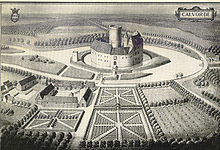


The term lowland castleorplains castle (German: Niederungsburg, Flachlandburg, Tieflandburg) describes a type of castle that is situated on a lowland, plainorvalley floor, as opposed to one built on higher ground such as a hill spur. The classification is extensively used in Germany where about 34 percent of all castles are of the lowland type.[1]
Because lowland castles do not have the defensive advantage of a site on higher ground, sites are chosen that are easy to defend, taking advantage, for example, of rivers, islands in lakes or marshes. Where such natural obstacles do not exist, artificially similar obstacles take on added significance. These include water-filled or dry moats, ramparts, palisades and curtain walls. In order to increase the height of the castle above the surrounding terrain, artificial earth mounds may be built (such as mottes), and fortified towers also fulfil this purpose.
Castles of the Early Middle Ages (including Slavic and Saxon castles) often had a narrow, deep ditch and high and steep earth ramparts.
Lowland castles are naturally found on plains such as the North German Plain or in the Netherlands, but they may also be encountered occasionally in highlands, for example in a valley as a so-called island castle (Inselburg) on an island in a river (e.g. Pfalzgrafenstein Castle).

Sub-types according to function:

| Authority control databases: National |
|
|---|